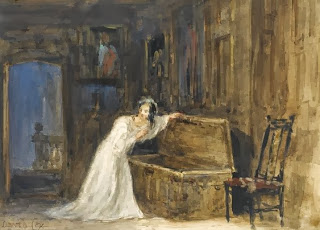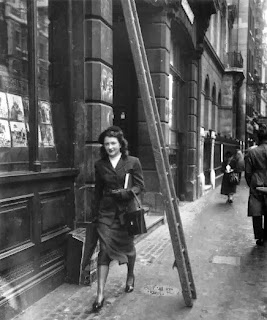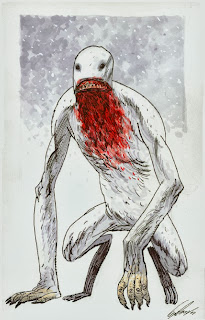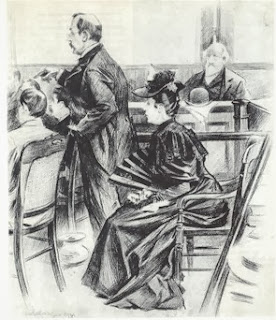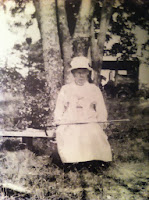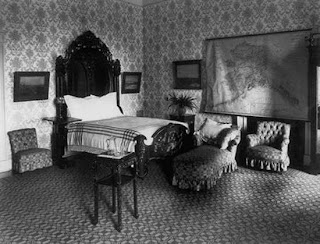 Legend Tripping, otherwise known as ostention, is a name that has been recently bestowed by folklorists and anthropologists on an adolescent practice in which a nocturnal pilgrimage is made to a site which is alleged to have been the scene of some tragic, horrific, or possibly supernatural event or haunting. Yup, totally had to go with the official definition there. Anyway, I'm pretty sure everyone has gone legend tripping at least once in their life. I personally have only done it once that I can remember. While visiting my cousins in New Jersey, I learned of the Atco ghost, the ghost of a young boy who had been run over in the street and now haunted the road. Knowing full well that I loved ghosts and spooky stuff, but also that I was incredibly afraid of ghosts and spooky stuff, my cousin decided that we should all drive out to the lonely road late at night. The legend was that if you flashed your lights, a bright light would appear on the road, which I guess signified the ghost. I don't remember much more, except that I didn't see anything and that I really had to go to the bathroom, so it wasn't that I was scared, I just wanted to get out of there. Don't ask any of my family members because they will disagree with this statement, but they are liars and big jerks. Needless to say, my experience with legend tripping wasn't that momentous, but that doesn't mean yours can't!
Legend Tripping, otherwise known as ostention, is a name that has been recently bestowed by folklorists and anthropologists on an adolescent practice in which a nocturnal pilgrimage is made to a site which is alleged to have been the scene of some tragic, horrific, or possibly supernatural event or haunting. Yup, totally had to go with the official definition there. Anyway, I'm pretty sure everyone has gone legend tripping at least once in their life. I personally have only done it once that I can remember. While visiting my cousins in New Jersey, I learned of the Atco ghost, the ghost of a young boy who had been run over in the street and now haunted the road. Knowing full well that I loved ghosts and spooky stuff, but also that I was incredibly afraid of ghosts and spooky stuff, my cousin decided that we should all drive out to the lonely road late at night. The legend was that if you flashed your lights, a bright light would appear on the road, which I guess signified the ghost. I don't remember much more, except that I didn't see anything and that I really had to go to the bathroom, so it wasn't that I was scared, I just wanted to get out of there. Don't ask any of my family members because they will disagree with this statement, but they are liars and big jerks. Needless to say, my experience with legend tripping wasn't that momentous, but that doesn't mean yours can't!.jpg) The first documented instance of legend tripping, though I'm sure this has been a thing dumb kids have been doing for thousands of years, is in Mark Twain's 1876 novel, The Adventures of Tom Sawyer. It's alright, you've probably never heard of it. The book contains several instances where the main characters visit a supposedly haunted site or an alleged lair for thieves. For there to be legend tripping, there first has to be an urban legend. Most communities has at least one urban legend/ghost story that they keep going, mostly just to make the town sound more interesting then it actually is. When I was growing up there were a few places in the surrounding towns that were said to be haunted. I've visited them all, as they have the benefit of also being places of business, but I wouldn't consider that legend tripping. I'm pretty sure I would've had to break in at night for it to be legend tripping. The point of \legend tripping is to test the veracity of the legend itself. The urban legend storytelling turns into a dare and someone has to make a trek into a cave or old house to prove that Old Man Jenkin's ghost doesn't capture little boys and girls that enter his house and make them watch Matlock with him. A good example of the dare format of legend tripping is the beginning of Tim Burton's Big Fish. In it, a young group of kids gather outside of a old woman's house who is supposed to be a witch. The main character is dared to go up there and knock on the door, testing the legend of this witch. The legend turns out to be true, with a future-seeing witch and everything. Many scary stories in my youth revolved around legend tripping and what would happen to kids if they dared go into haunted houses. Some of the stories involved a person having to do a ritual to get something to happen. Bloody Mary is a urban legend that can be tripped. It's the perfect example of legend tripping that involves a ritual. This, like many other dares stemming from legend tripping, often lead to the person's friends coming out and scaring them. What separates legend tripping from any other sort of tourism is the danger involved. Not only does legend tripping often lead to trespassing, but potentially injury or death. While kids may think they'll get hurt by a supernatural entity, when in reality they'll end up falling through the floor of an abandoned building. So, if you do decide to go to a dilapidated house, please be careful.
The first documented instance of legend tripping, though I'm sure this has been a thing dumb kids have been doing for thousands of years, is in Mark Twain's 1876 novel, The Adventures of Tom Sawyer. It's alright, you've probably never heard of it. The book contains several instances where the main characters visit a supposedly haunted site or an alleged lair for thieves. For there to be legend tripping, there first has to be an urban legend. Most communities has at least one urban legend/ghost story that they keep going, mostly just to make the town sound more interesting then it actually is. When I was growing up there were a few places in the surrounding towns that were said to be haunted. I've visited them all, as they have the benefit of also being places of business, but I wouldn't consider that legend tripping. I'm pretty sure I would've had to break in at night for it to be legend tripping. The point of \legend tripping is to test the veracity of the legend itself. The urban legend storytelling turns into a dare and someone has to make a trek into a cave or old house to prove that Old Man Jenkin's ghost doesn't capture little boys and girls that enter his house and make them watch Matlock with him. A good example of the dare format of legend tripping is the beginning of Tim Burton's Big Fish. In it, a young group of kids gather outside of a old woman's house who is supposed to be a witch. The main character is dared to go up there and knock on the door, testing the legend of this witch. The legend turns out to be true, with a future-seeing witch and everything. Many scary stories in my youth revolved around legend tripping and what would happen to kids if they dared go into haunted houses. Some of the stories involved a person having to do a ritual to get something to happen. Bloody Mary is a urban legend that can be tripped. It's the perfect example of legend tripping that involves a ritual. This, like many other dares stemming from legend tripping, often lead to the person's friends coming out and scaring them. What separates legend tripping from any other sort of tourism is the danger involved. Not only does legend tripping often lead to trespassing, but potentially injury or death. While kids may think they'll get hurt by a supernatural entity, when in reality they'll end up falling through the floor of an abandoned building. So, if you do decide to go to a dilapidated house, please be careful. Legend tripping takes place in many different locales. Cemeteries, houses, caves, woods, bridges, tunnels, and roads are the most popular. Some locations are hard to get to and may be dangerous, so local police try to keep people from entering. As you can imagine, this just makes legend tripping in these locations that more enticing. You'll notice in bigger towns and cities that the chamber of commerce encourages people to go legend tripping. This, of course, is to make money. If you aren't being charged to go on a haunted tour, at least the town is having you spend money there so you can check out the supposedly haunted cave on the north side of town. If a town endorses legend tripping, it isn't going to be dangerous. The most exciting legend trips are done without endorsement. Typically there will be at least three kids going to a legend site, where someone will re-tell the story. Then, someone attempts whatever ritual is required, if any, and they see what happens. Rituals can even involve sex, drug use, or alcohol. I don't know, kids do stupid stuff when they're scared. A lot of legend tripping involves graveyards. Kids are supposed to stand on graves or headstones, remove headstones altogether, or walk around a grave several times. Any combination of asinine rituals will eventually lead to something happening, or so the kids think. Successful or not, most are just happy that they had the courage to do the ritual. One common legend attributed the graveyards are the chair monuments. Most of these monuments are pretty old and were meant as a comfort for those grieving for loved ones. Now people call them devil chairs and fear that if one sits on them, they will be plagued with bad luck, or even summon the devil itself. Some legends surround gravestones and their ability to heal themselves. If a person knocks down an old grave, the grave will be found in its original position the next day.
Legend tripping takes place in many different locales. Cemeteries, houses, caves, woods, bridges, tunnels, and roads are the most popular. Some locations are hard to get to and may be dangerous, so local police try to keep people from entering. As you can imagine, this just makes legend tripping in these locations that more enticing. You'll notice in bigger towns and cities that the chamber of commerce encourages people to go legend tripping. This, of course, is to make money. If you aren't being charged to go on a haunted tour, at least the town is having you spend money there so you can check out the supposedly haunted cave on the north side of town. If a town endorses legend tripping, it isn't going to be dangerous. The most exciting legend trips are done without endorsement. Typically there will be at least three kids going to a legend site, where someone will re-tell the story. Then, someone attempts whatever ritual is required, if any, and they see what happens. Rituals can even involve sex, drug use, or alcohol. I don't know, kids do stupid stuff when they're scared. A lot of legend tripping involves graveyards. Kids are supposed to stand on graves or headstones, remove headstones altogether, or walk around a grave several times. Any combination of asinine rituals will eventually lead to something happening, or so the kids think. Successful or not, most are just happy that they had the courage to do the ritual. One common legend attributed the graveyards are the chair monuments. Most of these monuments are pretty old and were meant as a comfort for those grieving for loved ones. Now people call them devil chairs and fear that if one sits on them, they will be plagued with bad luck, or even summon the devil itself. Some legends surround gravestones and their ability to heal themselves. If a person knocks down an old grave, the grave will be found in its original position the next day.There are too many popular legend tripping areas to talk about, so I'll let you do some research. There are plenty of websites and books to help you locate popular locales. Legend tripping isn't just for kids, either. Sometimes it's just fun to go to legendary places and test your courage. Just don't expect anything spectacular to happen. Who knows though, these places are legends for a reason. Tell me in the comments about legend tripping that you've done!

